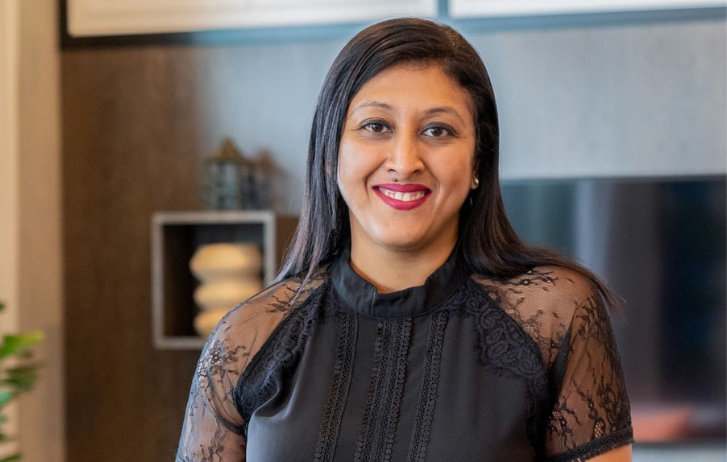
How Terrascope’s CEO Is Reshaping The Path To Net-Zero
By FedEx | August 26, 2024
Maya Hari is the CEO of Terrascope, a decarbonization platform empowering enterprises with the essential data they need to reach net zero, one climate goal at a time.
- Terrascope is an end-to-end decarbonization platform using agriculture value chain expertise to help businesses measure and reduce their emissions.
- Terrascope’s mission is to deliver climate data into the hands of large businesses with complex, global supply chains so they can operate more sustainably.
- Maya Hari, the CEO of Terrascope, reflects on her journey running the start-up and shares tips for enterprises focused on building a credible path to net zero.
When Maya Hari’s daughter came home from school one day in tears about climate change, Maya knew she needed to find ways to be part of the solution.
Today, as the CEO of decarbonization platform Terrascope, Maya describes herself as a data-driven optimist. The philosophy behind Terrascope is simple: understand what climate data is telling us and share those insights so businesses can act without delay.
By equipping companies with the emissions insights needed to take action, Terrascope’s goal is to help limit global warming to 1.5°C.
But can the business community achieve climate impact fast enough? We spoke with Maya to explore the most effective strategies for businesses hoping to reach net zero.
After a successful career in tech marketing, sales and operations, what made you take the leap into the sustainability sector?
Maya Hari: Transitioning into the climate tech industry allowed me to build on my existing skills to help solve the most critical challenge the world is facing today. It’s been a personal and transformative journey. I’ll never forget the day my daughter came home from school deeply upset about the state of our planet. She felt helpless because she couldn't join climate marches alongside her global peers like Greta Thunberg.
This really struck a chord with me. I decided to look for solutions to reassure and empower her to make a difference. We started a gardening project with our neighbors and the wider community, which was rewarding. But I wanted to do more to address the larger, systemic issues of climate change.
This sparked deeper reflection. How could I leverage my skills and leadership in the tech sector to address this pressing issue on a larger scale? I became an angel investor in climate companies and joined sustainability boards, finally taking up the role as CEO of Terrascope.
Real progress lies in the countless small victories and unexpected discoveries along the way.
How has Terrascope grown since its inception?
Since Terrascope launched, we’ve seen strong growth in both customers and partnerships. In just over two years, we’ve built a strong customer base that includes large global enterprises with extensive operations and supply chains.
What I find fascinating about decarbonization is that major goal-setting and climate crises often make the news, but real progress lies in the countless small victories and unexpected discoveries along the way. Many of our customers have found surprising, impactful opportunities to cut costs, boost efficiencies, and reduce their climate footprint. These small wins are crucial. Over time, they add up to significant emissions reductions.
One success driver is how we go beyond helping customers measure and reduce emissions. We’re also driving their innovation and future-proofing efforts. For instance, a global packaging company is using Terrascope to back up its green claims and track progress towards making products net zero.
We’re also working with a European construction firm to rethink their building materials and methods. And we’ve shared product emissions insights with a major Australian retailer, which are shaping its procurement and marketing strategies.
What is the biggest barrier for businesses big and small to commit to sustainability or net zero?
The biggest hurdle for many businesses is simply getting started and knowing what to tackle first. Embarking on a sustainability journey can be overwhelming. There are so many factors to consider, from the fear of not making a real impact to anxiety about accusations of greenwashing or greenhushing.
This is where technology really shines. Advanced data analytics and digital tools give businesses a clear picture of their operations and supply chains, pinpointing where they are making the biggest environmental impact and should focus their efforts.
These tools also help identify "low-hanging fruits" – easy, actionable steps that can quickly boost a company’s sustainability efforts. Plus, technology helps you set clear, measurable targets and track progress. This makes sure that sustainability initiatives are not only launched but sustained and scaled over time.
If small businesses are struggling to start on their path to net zero, what is one thing they can do to kick things off?
My advice is to simply take the leap. The very first step is to measure your climate footprint. Understanding the scale of your emissions and where they come from gives you a clear starting point for action. This doesn’t have to be complicated or expensive. Many tools are available for businesses of all sizes.
With this data, you can pinpoint areas for significant reductions. Businesses are often surprised by how simple and cost-effective these measures can be. Setting manageable goals builds confidence and demonstrates the benefits of sustainability efforts to all stakeholders. From there, moving toward net zero becomes a series of informed, strategic steps rather than an overwhelming task.
Remember, progress over perfection is crucial. Don’t wait for the ideal tool, team, or circumstances: just get started. Sustainability is a long-term journey with all kinds of opportunities and setbacks. It requires resilience and steady progress toward your goals.
What’s been the most surprising part of your CEO journey so far?
This role is unlike any other I’ve held. It’s taught me to embrace uncertainty and find opportunities in every challenge. I was ready for obstacles, but I didn't anticipate how often the landscape would shift, requiring quick pivots and new strategies. The complexity and pace of change in the climate tech space are more remarkable than in any other industry I’ve experienced.
I’ve also come to appreciate the immense importance of emotional intelligence. Empathy and understanding are vital in building a collaborative, motivated team. Connecting with people on a personal level is just as crucial as driving business results.
Finally, I’ve been struck by the power of storytelling in driving our mission. It’s not just about data and technology; it’s about inspiring people with the vision and possibilities of what we can achieve for businesses and the planet.
Is there a belief you hold that other business leaders might disagree with you on?
It’s often discussed in boardrooms as a major risk, but I believe climate change is a significant business opportunity. Many business leaders focus on the threats and challenges posed by climate change – and rightly so – but there’s immense potential for innovation and growth.
Balancing purpose and profit isn’t about tradeoffs. It’s about making them work together seamlessly.
I also believe that people possess a conscience and a desire to do good. The key difference lies in whether they feel they have the agency to effect change. We're the first generation to witness noticeable changes in our environment within our lifetimes. Our children are growing up with the stark realization that the planet may not be a viable home for them in the future. This awareness is a powerful motivator for change.
Finally, how can companies balance purpose and profit more successfully?
Balancing purpose and profit isn’t about tradeoffs. It’s about making them work together seamlessly. In our experience, companies that truly embed purpose into their core strategies enhance their brand, attract and retain top talent, and build stronger customer loyalty. Essentially, purpose and profit are two sides of the same coin.
Think of digital transformation in the early 2000s. Back then, companies that embraced digital didn’t just survive; they thrived. Today, purpose is the new frontier.
In the case of sustainability, every business decision should be evaluated through the lens of whether it is good for long-term business and the planet. More often than not, the answers align. Sure, some sustainability initiatives might come with higher upfront costs, but they frequently result in better financial outcomes, lower long-term expenses, and new growth avenues. Companies that get this right aren’t just making a difference. They’re setting themselves up to lead in the future.
***
In our Confessions of a CEO column, Asia’s leading entrepreneurs share real-life tips for businesses across the region. To read more entrepreneurship stories like Maya’s, subscribe to our monthly newsletter below, and keep your eyes peeled for the next edition.
SHARE THIS STORY
- How To Ship A Giant Panda
- How To Make Freight Shipments Work For Your Small Business
- The Rise Of Intra-Asia Trade: Opportunities In The China-Southeast Asia Corridor
- Southeast Asia's Role In Global Manufacturing Supply Chains
- 8 Most Unusual Shipments In The History Of FedEx
- Where Do Old Planes Go When They Retire?
Sign up now and save on your shipping rates!
Sign up now and earn discounts by shipping instantly with FedEx Ship ManagerTM at fedex.com.
Recommended For You
The Singaporean CEO Helping Companies Reach Net-Zero
Ted Chen, co-founder and CEO of Evercomm Singapore, shares how his AI start-up is making waves in the cleantech sector and helping companies.
How Greenie Web’s CEO Started His Decarbonization Business At 13
Ian Chew is the CEO of Greenie Web, a climate tech start-up based in Singapore that specializes in digital decarbonization.
The APAC CEO Transforming How Businesses Harness Data
Karen Kim’s cloud data platform, Human Managed, equips enterprises with the data intelligence they need to operate more efficiently.







